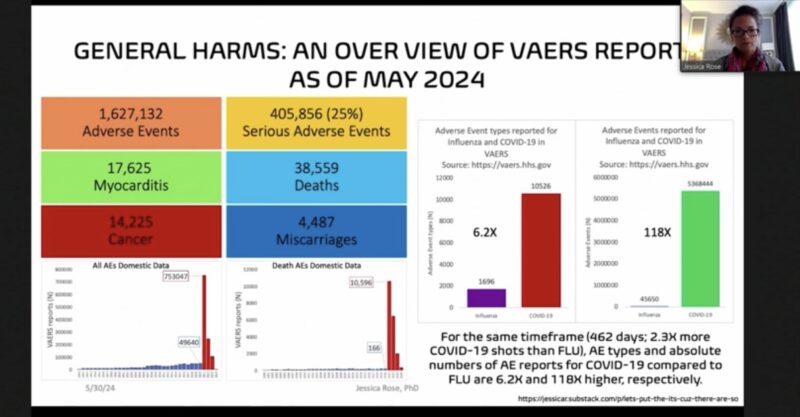Dr. Jessica Rose May 30th 2024 Testimony at NCI Regina, Saskatchewan
Dr. Jessica Rose’s presentation and testimony for the National Citizens Inquiry on May 30, 2024, covers
The CDC maintains modified mRNA products are not doing anything negatively with regards to DNA, despite many regulatory bodies fully admitted to contaminating DNA being present.
A synopsis relating to harms associated with DNA contamination and associated cancer risks.
Talks about corroborative evidence from Vaccine Adverse Events Reporting System (VAERS) Database. (CDC database that detects safety signals in post licensure use of vaccines).
Australian Federal court case currently going on regarding GMO issues.
We need to remind ourselves that some people say adverse events are not caused by the shots, so the way you provide the evidence of causation is with epidemiological criteria by using the ‘Bradford Hill’ method. Plausibility is one of these criteria, as outlined below.
For your information: Definition of the Bradford Hill criteria, otherwise known as “Hill’s criteria for causation,” are a group of nine principles that can be useful in establishing epidemiologic evidence of a causal between a presumed cause and an observed effect, and have been widely used in public health research. The principles were established in 1965 by the English epidemiologist Sir Austin Bradford Hill.
Sir Austin Bradford Hill proposed the set of nine criteria to provide epidemiologic evidence of a causal relationship between a presumed cause and an observed effect. (For example, he demonstrated the connection between cigarette smoking and lung cancer.) The list of the criteria is as follows:
- Strength (effect size): A small association does not mean that there is not a causal effect, though the larger the association, the more likely that it is causal.
- Consistency (reproducibility): Consistent findings observed by different persons in different places with different samples strengthens the likelihood of an effect.
- Specificity: Causation is likely if there is a very specific population at a specific site and disease with no other likely explanation. The more specific an association between a factor and an effect is, the bigger the probability of a causal relationship.
- Temporality: The effect has to occur after the cause (and if there is an expected delay between the cause and expected effect, then the effect must occur after that delay).
- Biological gradient (dose-response relationship): Greater exposure should generally lead to greater incidence of the effect. However, in some cases, the mere presence of the factor can trigger the effect. In other cases, an inverse proportion is observed: greater exposure leads to lower incidence.
- Plausibility: A plausible mechanism between cause and effect is helpful (but Hill noted that knowledge of the mechanism is limited by current knowledge).
- Coherence: Coherence between epidemiological and laboratory findings increases the likelihood of an effect. However, Hill noted that “lack of such [laboratory] evidence cannot nullify the epidemiological effect on associations”.
- Experiment: “Occasionally it is possible to appeal to experimental evidence”.
- Analogy: The use of analogies or similarities between the observed association and any other associations.
Some authors consider, also, Reversibility: If the cause is deleted then the effect should disappear as well.
Manufacturing and supply agreements contracts, (note: this is FOIA requested info, not readily publicly available) per country purchaser acknowledgement in section 5.5 states long term effects and efficacy are not currently known, and may be adverse effects not known. Since a universally documented acknowledgement, of predictable long term effects is circulating and signed then why is it a preposterous idea that of the millions of adverse events reported to government pharmacovigilant, such as VAERS, that some of them have a causal link? Therefore; the causal harms are plausible and predictable. Moderna filed a patent in 2018, that speaks to the dangers in introducing foreign DNA, and provides plausibility of harms. Besides 1.6 millions Adverse reactions reported, (not accounting for underreporting factor, as its a passive reporting system) 25% of adverse events are reported as serious, including death, disability, myocarditis, cancer, and miscarriage, which is 10% above what is considered the maximum normal range and considered acceptable so this is very high.
In 2021 something quite anomalous happened, and no good explanation was given, as to why 93% of reports filed were associated with COVID products.
WATCH this amazing video of Dr. Jessica Rose’s full NCI testimony:
***********************************************************************************************************************************

